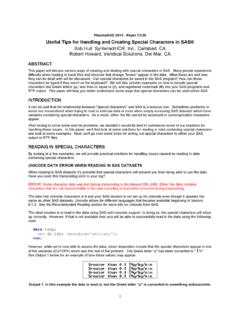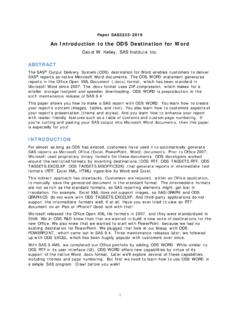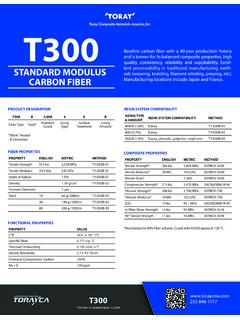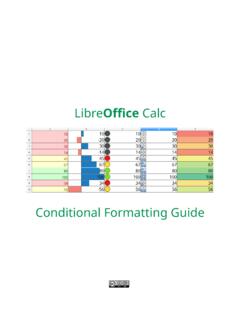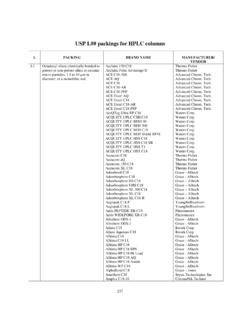Transcription of Using the New ODS EXCEL Destination in SAS® 9.4 When ...
1 Paper 169-2017. Using the New ODS EXCEL Destination in SAS When Working with Remote Servers Tom Bugg, Wells Fargo Home Mortgage ABSTRACT. The ODS EXCEL Destination has made sharing SAS reports and graphs much easier. What is even more exciting is that this Destination is available for use regardless of the platform. This is extremely useful when reporting is performed on remote servers. This presentation goes through the basics of Using the ODS EXCEL Destination and shows specific examples of how to use this in a remote environment. Examples for both SAS on Windows and in SAS Enterprise Guide are provided. INTRODUCTION. What is ODS EXCEL , and why use it? ODS EXCEL creates xlsx files in native format, regardless of the operating system being used. Other methods of getting SAS information included ODS HTML, Proc Export, and DDE (among others). ODS HTML created files that could be opened in EXCEL , but usually didn't produce desired look, were not native EXCEL output, and created very large files.
2 PROC EXPORT can export data, but not graphs and report results. The formatting is unreliable as well. DDE is flexible, but can be quirky and it may not be supported in the future. As with proc export, it outputs data, not reports and graphs, and in some cases data must be manipulated considerably before output. Using ODS EXCEL , you can put your output into EXCEL , keeping the formatting you desire. You can add graphics as well. And it's just plain cool to do something new! GETTING STARTED WITH ODS EXCEL . As with other ODS destinations, the ODS EXCEL sandwich has a top and bottom layer. An example of the top layer is below, and includes some of the available options: ods listing close; /* (note that this isn't necessary, but prevents duplicate output)*/. ods EXCEL file = "&my_excel_file.". options (embed_footnotes_once = 'on'. embedded_footnotes='on'. embed_titles_once = 'on'.)
3 Embedded_titles='on'. gridlines='off'. sheet_interval='proc'. sheet_name="Movement Matrix");. Additional information on the options available in ODS EXCEL can be found in the following locations: + EXCEL AFTER REPORT CODE: ods EXCEL close;. ods listing;. The EXCEL file is created when the ods EXCEL close; command is executed. The ods listing command turns the regular output back on (this is needed only if it was turned off in the step above). 1. MOVING THE FILE: In most cases, we're working in a UNIX/LINUX environment through PC SAS Using rsubmit, or via Enterprise Guide. Multiple choices are available for moving the EXCEL file into a Windows environment, depending on the SAS tool being utilized. The following method works in PC SAS without the need for an additional step outside of SAS: rsubmit;. proc download infile = "&my_excel_file.". outfile = "H:\My Documents\ " binary.
4 Run;. endrsubmit;. Please note the difference from normal download code the binary option is needed. Without it, the download will appear to work, but it will not be readable in EXCEL . DEMONSTRATION REAL EXAMPLE. The problem: We have an important reporting requirement that we produce officially once a year. We report on loans and dollars by a number of categories. When changes are made either based on changes in guidance or corrections, we need to understand the impact on our report We created a movement matrix to show the movement of dollars and units from category to category (by year) and wanted to publish it in a readable format in EXCEL The example shown is for PC SAS, and thus has all of the rsubmit and endrsubmit commands in the appropriate places. For demonstration purposes, a simple random number generation was used: rsubmit; Note use of tilde (~) here %let my_excel_file = ~ ; goes to user's default %sysrput my_excel_file = &my_excel_file.
5 ; location. Any location on the server can be used. /* Create user defined format which will be used to "bucket" the values */. proc format;. value bkt low - <-200 = "Negative 3". -200 - <-100 = "Negative 2". -100 - <0 = "Negative 1". 0 - <100 = "Positive 1". 100 - <200 = "Positive 2". 200 - high = "Positive 3";. run;. /* create some data for testing */. data rand1;. do i = 1 to 100;. x1 = rand("Normal")*100;. xmt = ranuni(0)*100;. output;. 2. end;. run;. data rand2;. do i = 1 to 100;. x2 = rand("Normal")*100;. output;. end;. run;. data rand3;. do i = 1 to 100;. x3 = rand("Normal")*100;. output;. end;. run;. /* combine the data */. data randomdata;. merge rand1 rand2 rand3;. by i;. Bucket1 = put(x1,bkt.);. Bucket2 = put(x2,bkt.);. Bucket3 = put(x3,bkt.);. run;. endrsubmit;. THE REPORT, INCLUDING THE ODS SANDWICH : /* close default listing output Destination */. ods listing close.
6 Rsubmit;. /* open the ods EXCEL Destination - output from all code between this statement and the "ods EXCEL close;" statement will be directed to &my_excel_file.*/. ods EXCEL file = "&my_excel_file.". options (embed_footnotes_once = 'on'. embedded_footnotes='on'. embed_titles_once = 'on'. embedded_titles='on'. gridlines='off'. sheet_interval='proc'. sheet_name="Movement Matrix");. title1 'Normal Distribution - Random Numbers';. title2 'Movement Matrix';. title3 'Dollars';. proc tabulate data=randomdata format=dollar24.;. where Bucket1 ne Bucket2;. var xmt;. class Bucket1 /order=unformatted missing;. class Bucket2 /order = unformatted missing;. table /* ROW Statement */. Bucket1 ='First Range'*Bucket2 = "Second Range", /* COLUMN Statement */. xmt ='Dollars'* sum=" " /box = 'Movement Matrix First to Second'. misstext = '$0';. 3. table /* ROW Statement */. Bucket2 = "Second Range"*Bucket1 ='First Range', /* COLUMN Statement */.
7 Xmt ='Dollars'* sum=" " /box = 'Movement Matrix Second to First'. misstext = '$0';. run;. title3 'Count';. proc tabulate data=randomdata format=comma7.;. where Bucket1 ne Bucket2;. var xmt;. class Bucket1 /order=unformatted missing;. class Bucket2 /order = unformatted missing;. table /* ROW Statement */. Bucket1 ='First Range'*Bucket2 = "Second Range", /* COLUMN Statement */. xmt ='Count'* n=" " /box = 'Movement Matrix First to Second' misstext =. $0';. table /* ROW Statement */. Bucket2 = "Second Range"*Bucket1 ='First Range', /* COLUMN Statement */. xmt ='Count'* n=" " /box = 'Movement Matrix Second to First' misstext =. '$0';. run;. title3 'Dollars';. proc tabulate data=randomdata format=dollar24.;. where Bucket1 ne Bucket3;. var xmt;. class Bucket1 /order=unformatted missing;. class Bucket3 /order = unformatted missing;. table /* ROW Statement */. Bucket1 ='First Range'*Bucket3 = "Third Range", /* COLUMN Statement */.
8 Xmt ='Dollars'* sum=" " /box = 'Movement Matrix First to Third'. misstext = '$0';. table /* ROW Statement */. Bucket3 = "Third Range"*Bucket1 ='First Range', /* COLUMN Statement */. xmt ='Dollars'* sum=" " /box = 'Movement Matrix Third to First'. misstext = '$0';. run;. title3 'Count';. proc tabulate data=randomdataformat=comma7.;. where Bucket1 ne Bucket3;. var xmt;. class Bucket1 /order=unformatted missing;. class Bucket3 /order = unformatted missing;. table /* ROW Statement */. Bucket1 ='First Range'*Bucket3 = "Third Range", /* COLUMN Statement */. xmt ='Count'* n=" " /box = 'Movement Matrix First to Third' misstext =. '$0';. table /* ROW Statement */. Bucket3 = "Third Range"*Bucket1 ='First Range', 4. /* COLUMN Statement */. xmt ='Count'* n=" " /box = 'Movement Matrix Third to First' misstext =. '$0';. run;. title 'Histogram of 3 Random Selections';. /* create a bar chart!
9 */. ods graphics / height=400 width=800 noborder;. proc sgplot data=randomdata;. histogram x1;. histogram x2;. histogram x3;. run;. /* close the ods EXCEL file */. ods EXCEL close;. endrsubmit;. ods listing;. SAMPLE OUTPUT. The code will create 5 tabs, with the last tab being the histogram. The report in EXCEL will look like this: Movement Matrix First to Dollars Second First Range Second Range $251. Negative 1 Negative 2. Positive 1 $410. Positive 2 $120. Positive 3 $12. Negative 2 Negative 1 $203. Positive 1 $96. Positive 2 $65. Negative 3 Negative 1 $76. Negative 2 $11. Positive 1 $86. Positive 1 Negative 1 $602. Negative 2 $258. Negative 3 $45. Positive 2 $348. Positive 3 $131. Positive 2 Negative 1 $304. Negative 2 $196. Positive 1 $183. Positive 3 Negative 1 $17. Negative 2 $54. Positive 1 $70. The last tab will contain a histogram looking something like this: 5.
10 PROGRAMMATICALLY DOWNLOADING FILE IN ENTERPRISE GUIDE: For users of Enterprise Guide, the method of downloading will be different, but can still be done programmatically: After running the program, double-click on the Process Flow in the Project Tree, or select View | Process Flow from the main menu Select the xlsx file (it will have a plain white icon and if you wrote the file to your home directory path, you should see the start of the path /users/ap ) and Right-Click to bring up a menu Select Export and then Export as a Step In Project . Click Next. Select Local Computer and click the Browse button. Navigate to the path where you want the file to land. Change Files of type: to All File Types Notice that the file name is the path and file name from the server, but all slashes and dots have been replaced with underscores, and a .txt has been added by default. Change the file name to something appropriate and make sure that it ends with the proper suffix.













